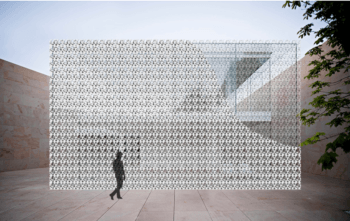Texas A&M Researchers Enabling Buildings To ‘Breathe’

Buildings may one day “breathe,” and they might be able to function in their own environment with the help a type of “smart skin” developed by a team of Texas A&M University researchers.
View a video about the project from the NSF.
The team from the College of Architecture, comprised of Zofia Rybkowski, Negar Kalantar, Ergun Akleman, Tahir Cagin and Terry Creasy, is supported by an approximately $240,000 grant from the National Science Foundation. The goal of the research, the team said, is to make a building that is attractive and functional, but also more energy efficient.
Using what they call a “shape-memory polymer,” the team has developed building skins that could allow a building to breathe on its own, much like a living system.
“When it’s hot, we want the building skin to be open to absorb air, and when it’s cold, we want it closed, without using external mechanical devices or electrical devices,” said Maryam Mansoori, one of more than 60 Texas A&M students who are also heavily involved in the project.
The researchers are using materials including alloys and stimuli-responsive polymers to enable a building that has a “smart skin” applied to it to function almost as a living thing in its own environment.
“We started to think, can we create a system that is self-regulated based on the inherent properties of the materials themselves?” Rybkowski said.
Builders and designers may be able to use heat or light to get the desired effect they want, the team said. The polymers are designed to draw fresh air into the building, which allows it to actually breathe on its own, the team said.
Kalantar is using high-tech 3D printers to aid in the design and construction of the polymers.
Rybkowski said there are “lots of materials that are used now that are responsive to environmental cues,” and the team hopes to identify these and more to use as smart-skin building layers.
The key focus area in the project is sustainability, Rybkowski added.
“Can we use what already exists in our own environment and incorporate that into the anatomy of our buildings? That is the big picture here,” she said.
With more research, the team believes it can go farther and use materials that help self-regulate not only building temperature, but air quality and also water conservation.
Media contacts:
- Zofia Rybowski, 979-845-4354, zrybowski@tamu.edu.
- Keith Randall, 979-845-4644, keith-randall@tamu.edu.





